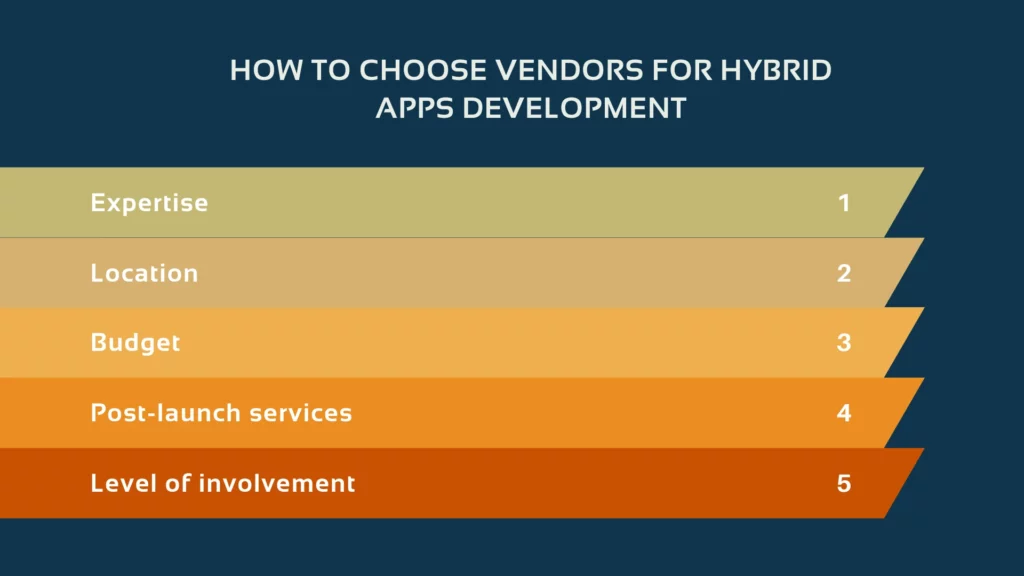Reasons to choose hybrid mobile app development


Statista claims that mobile apps will cross a threshold of 258 billion by 2022. One of the leading mobile app development trends, ensuring a cross-platform functionality – hybrid apps – remains visible and relevant in the modern IT landscape. Hybrid apps use popular technological frameworks and languages (JavaScript, CSS, Swift, HTML5), and they also have lightweight native app containers in their core. Accordingly, hybrid apps can achieve native performance using frameworks like React Native, thanks to blended features. Hybrid apps possess fast and seamless performance (even in offline mode) and responsive design despite their web origins.
It is also noteworthy that 74% of the top retail apps in America are hybrid (Amazon, Nike, Walmart), as they enable companies to attract a more extensive client base.
Yet, that’s not a full list of hybrid apps’ benefits: since they require a single code base, it shortens the development process. Less code to maintain makes that solution more economical than native applications. However, hybrid platforms are no less familiar to audiences around the globe. Here are the most telling examples of solutions we all use regularly:
Gmail – is the most used email client based on AJAX, JavaScript, Vue.js and jQuery on the front end.
Twitter – a progressive web app, working excellently even with a poor internet connection, which helps to deliver seamless UI performance.
Instagram – the hybrid application, so-called image-focused social media platform created based on React Native.
Uber – the solution that uses a web React UI framework, which allows Uber mobile apps to work on m.uber.com.
Despite the relatively slow speed of the first hybrid apps, applying cutting-edge frameworks and innovative technologies shrunk the gap between native and hybrid performances. So let us now dwell on most hybrid app frameworks, allowing us to build a solution from scratch. One of the significant benefits of using that approach is that you can write code once to use it across different mobile devices repeatedly.

Created by Facebook, it provides developers with native views (instead of utilising the traditional web view, they can go one step further). That is why a multitude of hybrid apps use this tool to comply with their codebases into native code. As code reusability works only on mobile platforms, web solutions need slight modifications to port over to mobile. Microsoft, Uber, and Facebook are among the market leaders who have previously turned to React Native.
Unlike the previous option, Ionic adapts the traditional web approach for building hybrid platforms. It is one of the most popular frameworks of that kind: web-based code is embedded in a web view that, for its part, interacts with exposed native APIs through various plugins. Ionic comprises front-end building block libraries, multiple UI components and other design features.
A veteran among frameworks, the proven option also provides native app features as needed. The mechanism is precise: developers can run SPA (single-page application) using an integrated mobile web browser. As a result, users may create native-like apps for Android and iOS by accessing primary devices’ capabilities (network status, data, sensors, and so on).
Microsoft’s solution is distinctive by a higher learning curve compared to previous frameworks. Developers are free to write in C# and take full advantage of the .Net development ecosystem. Thanks to C# wrappers, you can achieve a native performance, which nonetheless won’t lead to sacrificing the reusability of your code.
Although the framework is a newcomer in the hybrid app development landscape, many companies implement Flutter to optimise the development cycles of dynamic and static languages. Just-in-time (JIT) and ahead-of-time (AOT) compilations are crucial to obtaining faster cycles of dynamic languages and the stability and reliability of static languages respectively.

First, focus on considering several things to make your digital journey smooth and consistent:
It is also crucial to select a preferred type of collaboration which falls into one of the categories:

PNN Soft has been delivering programming products for 20 years, and we hone our skills to put our ideas into reliable services. We created a wide variety of hybrid apps for Windows/macOS X. In this process, special attention is paid to security.
We focus on achieving an in-depth understanding of individual companies’ goals and needs. That is why our clients prefer long-term cooperation.
PNN Soft prioritises Agile, Scrum, and RAD methodologies to communicate with clients effectively, satisfy customers’ expectations and obtain more flexibility. Our Agile teams of experts include software developers, GUI designers, testers, technical writers, and managers.
If you are interested in hybrid application development, fill out the form below.